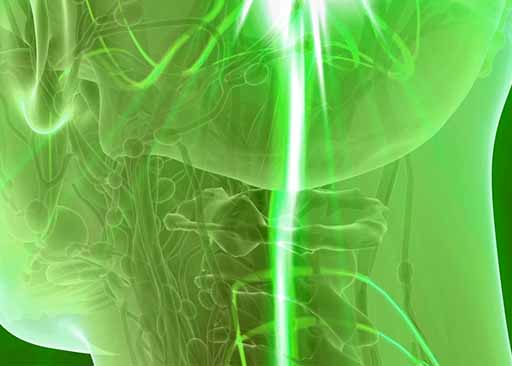Vagus Nerve – The Mysterious Link Between Brain And Body
 The vagus nerve, also known as the X cranial nerve, is a motor and sensory nerve that comes from the brain and runs through the neck, chest, and abdominal cavity. This nerve helps to regulate your heartbeat, respiratory rate, and other autonomic functions.
The vagus nerve, also known as the X cranial nerve, is a motor and sensory nerve that comes from the brain and runs through the neck, chest, and abdominal cavity. This nerve helps to regulate your heartbeat, respiratory rate, and other autonomic functions.
It also has three main branches: pharyngeal for swallowing and taste sensation, cardiac for regulating heart rate, and the pelvic for controlling bladder.
It has been called the “wonder nerve” because of its many functions. It’s also one of the most mysterious nerves in the body, and scientists are still learning about its role in health. But what is clear is that the vagus nerve is essential for maintaining good health both physically and mentally.
Three Branches of the Vagus Nerve
- Pharyngeal Branch (Swallowing, Taste Sensation) – The pharyngeal of the X cranial nerve is responsible for swallowing and taste sensation. This originates in the brainstem and travels down to the throat, where it controls the muscles used for swallowing. It also sends sensory information to the brain about what we’re tasting.
Moreover, pharyngeal helps regulate the gag reflex, which is vital for preventing us from choking on food. It also plays a role in speech and singing by helping to control the larynx muscles (voice box).
- Cardiac Branch (Heart Rate, Pericardium Inflammation, Aortic Arch Contraction/Relaxation, Coronary Vasoconstriction, Myocardial Contractility, Visceral Sensations of the Heart, Cardiovascular Functions) – Cardiac controls heart rate and a variety of other cardiovascular functions.
It originates in the brainstem and travels down to the heart. It regulates the contractility of the myocardium and sends sensory back to the brain about how the heart is feeling. It also helps control inflammation around the pericardium and regulates blood flow through the aortic arch.
This also sends signals that affect blood vessel constriction or dilation (depending on whether you need circulation). The cardiac contributes to regulating cortisol levels by affecting the release of certain adrenal hormones.
- Pelvic Branch (Bladder, Bowel, and Sexual) – The pelvic controls bladder, bowel, and sex. This originates in the brainstem and travels down to the pelvis, where it regulates the muscles involved in urination and defecation. It also sends sensory about sex to the brain.
While this doesn’t control sexual arousal, it contains signals that help maintain erections and ejaculations.
These three branches control a wide range of important bodily functions when combined. The vagus nerve is essential for maintaining good health.
Stimulating the Vagus Nerve
The X cranial nerve or the tenth cranial nerve is stimulated by eating and drinking. It has also been called the “care of food” or the “gut feeling.” The digestive system uses most of the body’s energy when you eat, so it helps to keep your brain clear for other tasks.
In some cases, you can stimulate this nerve through medical devices that send electrical signals to the nerves through the skin. Certain medications may also enable it, such as antidepressants and anti-seizure drugs.
For those who want to use natural methods, eating is one of the easiest ways to keep this nerve active throughout the day. Other activities that stimulate it include meditation, deep breathing exercises, massage therapy, and getting a good night’s sleep.
Benefits of Nerve Stimulation
Stimulating this nerve has been shown to have several benefits. It includes improving memory and reducing inflammation, anxiety, depression, and other stress-related symptoms. It can also help to affect heart health and regulate blood pressure.
Learning about it can help you take better care of your body. It is essential for maintaining both physical and mental well-being, so keeping it active throughout the day can lead to many benefits that affect both quality of life and longevity.
Researchers believe that stimulating the vagus nerve may also help to address chronic digestive issues like acid reflux. Vagal maneuvers like the Valsalva maneuver and abdominal breathing are helpful in these cases.
Vagus Nerve Stimulation and Weight
The vagus nerve may also play a role in weight. Some researchers have hypothesized the vagus nerve could help to reduce appetite, increase metabolism, or both. It’s consistent with research showing that low activity levels in this nerve are associated with obesity.
Stimulating the vagus nerve may help achieve short-term weight loss in people with obesity and related health complications. However, more research is needed before we can definitively say whether this method is effective for long-term use in people who are not obese.
When The Nerve Gets Damaged
The vagus nerve is one of our most essential nerves, but there are times when it gets damaged, like with traumatic brain injury (TBI). People who have had a TBI may experience several side effects, including nausea and vomiting. They may also have difficulty taking in food or liquids because of vagus nerve damage.
Therefore, TBI can lead to so many difficulties with eating – the brain doesn’t tell the digestive system to slow down when it needs more time for chewing and processing. Alternatively, the person may not feel the urge to eat or drink, leading to malnutrition and dehydration.
Other things can affect the vagus nerve, like infections, autoimmunity, and surgery. These conditions can all lead to issues with food consumption, and overall health.
Many people recognize the vagus nerve as a key player in the heart and digestion, but it is also vital for speech, sweating, and coughing. Vagus nerve damage can cause issues with walking, talking, and other neurological issues that indicate something may be wrong with the brain or spinal cord.


Boosting Memory
When you’re trying to improve your memory by cramming for an exam, you might not think of the vagus nerve. But this vital nerve may help by increasing the release of neurotransmitters in the brain.
One study found that people who received vagus nerve stimulation showed improved performance on a task that measured short-term memory and attention span. The researchers believe that this is because vagus nerve stimulation increases the release of serotonin and other neurotransmitters in the brain that are important.
Vagus Nerve Stimulation as a Tool
X cranial nerve stimulation is a potential solution for other conditions, including epilepsy and Alzheimer’s.
Epilepsy is caused by abnormal brain activity that causes seizures. Researchers are exploring whether the stimulation can help reduce the frequency of these events by affecting the release of neurotransmitters in the brain. This type of therapy is helpful in some people with epilepsy.
Alzheimer’s is a progressive brain issue that causes memory loss and other cognitive issues. There is no cure for Alzheimer’s, but stimulation may be able to help delay the progression.
Stimulation To Reduce Hypertension
Hypertension involves high blood pressure that puts stress on the heart and other major organs. Researchers are exploring whether the stimulation can help reduce hypertension by controlling the release of nitric oxide (NO) in the brain. Nitric oxide is produced naturally by cells and plays a vital role in various functions, including digestion and regulating blood pressure.
There are many ways to stimulate this, including wearing a device on your neck and sending electrical impulses through it. These techniques help by increasing neurotransmitter production in the brain.
Other Problems
When the vagus nerve doesn’t work properly, it can cause many problems. People may experience depression, anxiety, high blood pressure, and a weakened immune system.
People living with specific conditions often have a higher risk of developing complications that affect the vagus nerve. These include Parkinson’s, rheumatoid arthritis, ulcerative colitis, and irritable bowel syndrome. People who suffer from epilepsy or migraines are also at risk.
A doctor may order an ECG to check the heart’s rhythm or an MRI to look for brain or spinal damage. There is no one-size-fits-all solution. Options will vary depending on the condition and its severity.

Physical Therapy and Lifestyle Changes
The nerve is also responsible for sending signals between the brain and the gut. Therefore, the vagus nerve can lead to digestive issues, such as constipation or diarrhea.
Aside from ECG or MRI, measuring the heart rate variability (HRV) is an excellent way to assess the vagus nerve activity. HRV measures how much variation there is between heartbeats. The more variation, the healthier the nerve is.
How BioScan Can Help
BioScan is a non-invasive device that can measure body activity. It does this by measuring galvanic skin response, a good indicator of overall health.
If your patients have any of the symptoms associated with vagus nerve damage, BioScan can provide a detailed report that provides an overall health assessment. This information can help identify the root cause and create a plan.
